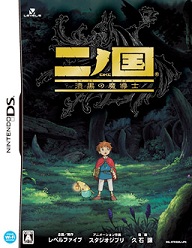Soul Nomad and the World Eaters
PlayStation 2
Reviewed: 09/12/2007
 It was bound to happen eventually. With Disgaea having had free run of the place, of course it’s going to end up finding some hapless SNES game to knock up. Sure, Ogre Battle might have stood a chance, but once one stares into those deep, gorgeous eyes, one can’t help but be smitten. Eventually they got married (immediately after this, no less), and had a child. This, what some may refer to as “unholy union,” has been christened Soul Nomad and the World Eaters.
It was bound to happen eventually. With Disgaea having had free run of the place, of course it’s going to end up finding some hapless SNES game to knock up. Sure, Ogre Battle might have stood a chance, but once one stares into those deep, gorgeous eyes, one can’t help but be smitten. Eventually they got married (immediately after this, no less), and had a child. This, what some may refer to as “unholy union,” has been christened Soul Nomad and the World Eaters.
Players begin by choosing a sex and name for their character, and immediately afterwards meet Danette, the main character’s childhood friend. Both are summoned to the chambers of Lady Layna, their village’s leader, where the main character is given the soul of Gig, a murderous and foul-mouthed “god” that originally set the titular World Eaters loose upon the world. He lends some of his power to his vessel, determined to eventually take it over and resume his rampage. This power is much needed as the World Eaters, after years of slumber, are stirring again. It is, of course, up to the player to set things right.
The squad-based battle system of yore, hailed in many a legend as the Holy Grail of strategy RPG combat systems, finally makes a return in Soul Nomad. It’s actually not as legendary as all that, or there’d probably be something about it in an encyclopedia or similar text. Regardless, veterans of previous NIS SRPGs will find themselves treading less familiar ground. Battles are turn based and take place on a square-filled grid, as per usual, but the addition of squads adds quite a bit of depth to the system. Up to nine different characters can be arranged in a room to form a squad, with unit placement and combinations determining the types of attacks that are unleashed. A healer in the back row, for example, will heal the entire squad as opposed to a single row were it placed in the center; meanwhile, a warrior does absolutely nothing in the back. Additionally, squads are assigned leaders which determine special attacks and tactical abilities. Without a leader, the squad is nothing, and if the leader dies, the squad dies with it.
 |
| That is not a small monster. In fact, that is a big monster. |
Squad formations are determined by room layout. As the game progresses, players gain access to more rooms, which can be replaced with a random room with the use of the “change” command. This allows for better unit placement and different room abilities. Room locks are acquired during the game as well, which allow the player to hold onto a particularly desirable room while they sift through others. Additionally, rooms can be augmented with decorations, which provide a variety of bonuses in addition to the room’s normal effect. Unfortunately, these decorations only last for one battle, after which they are presumably sent to the great beyond, to chill with lava lamps and pet rocks in the decoration afterlife. Rooms can also be inspected, which sends the player into a series of random dungeons and gives them the chance to increase the room’s bonuses.
Maintaining an army is, unfortunately, expensive work. Summoning a squad to battle costs “Gig Points,” this game’s form of currency, with the price increasing as the squad’s strength does. Units and items are (in a massive twist) bought with Gig Points as well. Unit level can be adjusted upon purchase this time around, alleviating the need for hours spent grinding to level up new squad members. Most items do generally what is expected of them, healing various deficiencies and performing various tasks, while a few grant the ability to pick fights with random townspeople, which can bring forth several different rewards ranging from GP to items. Mostly just GP and items, however. …Actually, that’s it. It’s important to not be too hostile toward the townsfolk, however, as one bearing a grudge can show up in the middle of a fight to exact its revenge upon a heartless player’s callous forces.
 |
| Unit placement is key! |
Players familiar with NIS’s art style will find little new here. Newcomers will find themselves staring at 2D sprites that might look at home on a PS1, with very well-done attack animations coupled with flat and drab battle maps. That last one is actually the new, and is a bit of a step down from previous games, where the maps were at least in 3D. The musical stylings of Tenpei Sato are much improved this time around, producing a darker and more involving soundtrack which serves to set the tone of the game superbly.
Overall, Soul Nomad and the World Eaters is a wonderful addition to the NIS family of tactical RPGs, providing a deep and enjoyable combat system along with a serious plot that quite surpasses its predecessors, while still retaining a certain level of humor that Nippon Ichi is known for. Where else could one get the line, “You sister-loving man-cow!”?
-Quinton Alexander
| Score Breakdown | ||
| Overall Great Out of 10 See our Review Criteria |
Gameplay | Legendary |
| Story | Excellent | |
| Graphics | Below Average | |
| Sound/Music | Very Good | |
| Replay Value | Good | |
| The Verdict: 8 | ||








